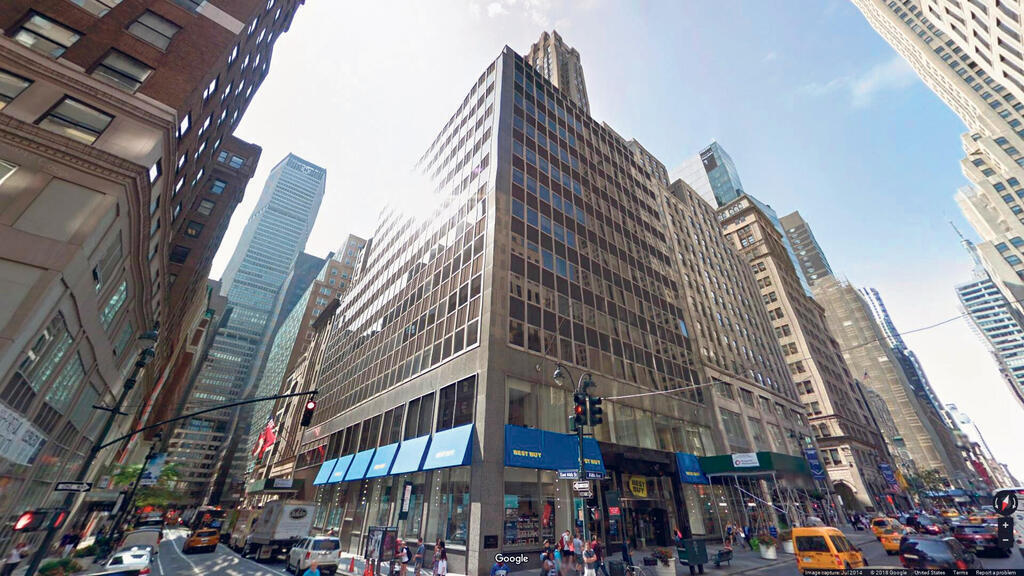Getting your Trinity Audio player ready...
The increase in interest rates in the U.S., which is causing a relative freeze in the real estate market in New York, is also starting to affect institutional investors in Israel.
More stories:
Israeli investment house Altshuler Shaham and its partners are expected to write off nearly 140 million shekels following an investment they made in an office building in Manhattan that failed due to high financing costs.
3 View gallery


The investment in Manhattan's 529 Fifth Avenue office building failed due to high financing costs
(Photo: Google)
Altshuler Shaham, Psagot, and Amitim Insurance collectively made the original investment in the office building in New York, known as 529 Fifth Avenue. The three investors joined forces in late 2014 and formed a real estate company called Silverstein Properties, which was supposed to enhance and manage the property.
Amitim Insurance and Psagot invested 100 million shekels each, while Altshuler Shaham invested 50 million shekels, and in return the three institutional investors received a 30% stake in the building. The total investment in the office building, which has 20 floors, amounted to an estimated 830 million shekels.
Seven years later, in 2021, Altshuler Shaham acquired Psagot for an estimated value of 910 million shekels. After the acquisition, Psagot’s assets were transferred to Altshuler Shaham, along with the rights to the building at 529 Fifth Avenue, theoretically increasing Altshuler Shaham's investment in the building to 150 million shekels.
Silverstein Properties, which issued bonds to raise capital on the Tel Aviv Stock Exchange with a total value of over one billion shekels, reported that two major tenants renting in the property decided to terminate their lease agreements due to the occupancy rate dropping from 94% to 44% and the average rental fees decreasing from $60 per square foot per year to $48 per square foot.
In parallel, there has also been an increase in Silverstein Properties’ financing expenses due to a loan taken for the property, carrying a Libor interest rate of + 5.25%, with repayments due in October 2023.
Moreover, Silverstein Properties’ subsidiary, which holds the property, failed to meet one of the financial requirements set for the loan. As a result, the funds in its account, after monthly expenses were paid, were deposited into a restricted account.
Following the surge in financing costs, Silverstein Properties sold the building in March for $103.5 million. According to the company's reports, the building’s fair value at the end of the third quarter of 2022 was estimated at $192 million after several assessments. Therefore, it will lose a sum of $88 million after completing the sale.
Based on Silverstein's loss calculation, Altshuler Shaham's initial investments (including that of Psagot) and Amitim Insurance's investments are expected to be reduced by 138 million shekels after the property is sold.
Altshuler Shaham has the primary ownership stake in the property. In its asset report for the end of the year’s first quarter, Altshuler Shaham's valued the New York property at a fair value of only 41 million shekels.
According to market estimates, the value loss carried out by Silverstein Properties is one of the largest that took place this year in New York’s real estate market.
In recent years, Israeli institutional investors have preferred to buy more holdings in the non-traded market and reduce their dependence on the stock market. Insurance companies and investment houses sought assets that would provide them with a fixed return on their money, such as rental income, alongside the increase in the investment's value over time.
Non-traded asset investments primarily replaced investments in government and corporate bonds, which ceased to be attractive due to the low-interest rates offered in the market.
According to investors opposed to investing in non-traded assets, this activity weighs on the yield of pension fund savers during a crisis since they can’t be liquidated quickly. That’s why when investors seek to withdraw their money, institutional investors prefer to liquidate traded assets first and only then, during a crisis, sell non-traded assets at a loss.
Supporters of investment in the non-traded market argue that it’s a strategy that allows for reducing monthly return volatility and minimizing dependence on the stock market. They also argue that, over time, non-traded market returns are preferable to those achievable in the traded market.



